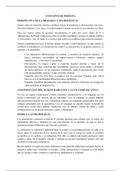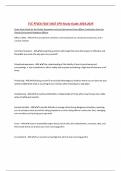UNIT 1 INTRODUCTION
1. The components of grammar
The word grammar comes from old French gramaire, via Latin from Ancient Greek grammatiké
- teckhné (art of letters), gramma (letter of the alphabet, thing written
Definitions of grammar
- A grammar of a language describes the principles or rules governing the form and meanings
of words, phrases, clauses, and sentences.
- The grammar of a language consists of a set (or sets) of rules which generate a set of
sentences: in the case of all natural languages, an infinite set of sentences. Any sentence not
generated by the rules is, by definition, ungrammatical.
Lexicon: the words or vocabulary in the mental dictionary
- Contains all the words a speaker knows, between 45,000 and 60,000.
- To know a word means knowing its pronunciation, its morphology, its meaning and its syntax
Morphology: the structure of words
- In English, words are composed of bare of roots or roots with affixes (prefixes or suffixes).
- The basic unit of analyses of morphology is the morpheme
Syntax: the structure of phrases and sentences
- It is the study of order and arrangement of words into larger units such as phrases, clauses and
sentences.
- Syntax knowledge allows speakers to recognise ungrammatical sequences. For example, the
big house vs *the house big, this is an example of a wrong grammatical position.
- It also allows the speakers to recognise syntactic ambiguity.
Semantics: the meaning of words and sentences
- Lexical semantics: the meaning of individual words. Lexical ambiguity: a word can mean
more than one thing
- Sentence semantics (compositional semantics): the meaning of sentences. Syntactic ambiguity
Phonetics and phonology: the sounds and the sound systems or patterns
- Phonology is the study of speech sounds of a particular language. It also studies possible
sound combinations.
- Knowing the phonology of your language allows you to produce sounds that form meaningful
utterances, recognise foreign accent, know if a sound belongs to a language or not, know if a
sound is distinctive or not. This is known as phonological competence.
- An example of a distinctive sound is thin and sin.
- A pair of words that differ by one sound is called minimal pair
- A distinctive speech sound is called a phoneme
Pragmatics: the study of the functions of language and its use in context. Studies utterances, which
are always found in specific contexts. Meanings may be inferred from non-linguistic information.
1.2 Descriptive and prescriptive grammar
, Descriptive grammar
It is a grammar that describes how native speakers of a language use it.
- Native speakers are the only “authority” because the grammar describes what speakers say.
- Everything that is used by native speakers will be included in descriptive grammar.
- Descriptive grammar defines how something is used, not how it must be used. Ex:
nothing=anything: negative polarity item.
A descriptive grammar will contain the rules that describe the language used by native speakers.
Example of rules:
- Determiner + Noun: determiners precede nouns
- Adjective + Noun: adjectives precede nouns
- Demonstratives and nouns agree: they share features
These rules are established because the language is like this, not because an institution has decided
that it should be like this.
- The sequences *a cat/ * a cat black/*These black cat are ungrammatical because they do not
follow the rules of English grammar.
- These rules can be disobeyed in poetry or songs, but if they are disobeyed is ungrammatical.
There is variation in the use of language:
- In him/he varies the object and the pronoun. He is nominative and him is accusative.
Prescriptive grammar
It expresses a preference when there is a choice in a construction that varies (as in the choice of
pronoun). Determines how something must be used.
- Prescriptivism in English appears in the 18th century, scholars felt there was a need to fix the
grammar of English. That’s because there was not the only language spoken in England at that
time, French and Latin were also used. English was not a language of prestige.
- In 1635 France created the Académie Française with the objective of “fixing the grammar”
and “protecting the language”
- In 1713 Spain created the Real Academia Española de la Lengua with the same objectives.
- In 1762 Robert Lowth wrote “Short Introduction to English Grammar”. This was the first
prescriptive grammar of the English language. They wrote dictionaries and grammars of
English.
- The prescriptive grammar was the dominant type of grammars in the 18/19th century, so the
speakers had to learn the “correct version” of the language. Many common constructions
spoken by speakers were regarded as uneducated (colloquial).
2.1 Words and their morphological properties
Morphology is the study of words and their internal structure (how are they formed), but what is a
word?
- Written language: a unit between two spaces (orthographic boundaries)
- Spoken language: potential pauses
- Meaning: the relation between a meaning and a set of sounds, which has grammatical use.
But there are idiomatic expressions and phrasal verbs.
- A word is a meaningful linguistic unit that can be combined to form phrases and sentences.
1. The components of grammar
The word grammar comes from old French gramaire, via Latin from Ancient Greek grammatiké
- teckhné (art of letters), gramma (letter of the alphabet, thing written
Definitions of grammar
- A grammar of a language describes the principles or rules governing the form and meanings
of words, phrases, clauses, and sentences.
- The grammar of a language consists of a set (or sets) of rules which generate a set of
sentences: in the case of all natural languages, an infinite set of sentences. Any sentence not
generated by the rules is, by definition, ungrammatical.
Lexicon: the words or vocabulary in the mental dictionary
- Contains all the words a speaker knows, between 45,000 and 60,000.
- To know a word means knowing its pronunciation, its morphology, its meaning and its syntax
Morphology: the structure of words
- In English, words are composed of bare of roots or roots with affixes (prefixes or suffixes).
- The basic unit of analyses of morphology is the morpheme
Syntax: the structure of phrases and sentences
- It is the study of order and arrangement of words into larger units such as phrases, clauses and
sentences.
- Syntax knowledge allows speakers to recognise ungrammatical sequences. For example, the
big house vs *the house big, this is an example of a wrong grammatical position.
- It also allows the speakers to recognise syntactic ambiguity.
Semantics: the meaning of words and sentences
- Lexical semantics: the meaning of individual words. Lexical ambiguity: a word can mean
more than one thing
- Sentence semantics (compositional semantics): the meaning of sentences. Syntactic ambiguity
Phonetics and phonology: the sounds and the sound systems or patterns
- Phonology is the study of speech sounds of a particular language. It also studies possible
sound combinations.
- Knowing the phonology of your language allows you to produce sounds that form meaningful
utterances, recognise foreign accent, know if a sound belongs to a language or not, know if a
sound is distinctive or not. This is known as phonological competence.
- An example of a distinctive sound is thin and sin.
- A pair of words that differ by one sound is called minimal pair
- A distinctive speech sound is called a phoneme
Pragmatics: the study of the functions of language and its use in context. Studies utterances, which
are always found in specific contexts. Meanings may be inferred from non-linguistic information.
1.2 Descriptive and prescriptive grammar
, Descriptive grammar
It is a grammar that describes how native speakers of a language use it.
- Native speakers are the only “authority” because the grammar describes what speakers say.
- Everything that is used by native speakers will be included in descriptive grammar.
- Descriptive grammar defines how something is used, not how it must be used. Ex:
nothing=anything: negative polarity item.
A descriptive grammar will contain the rules that describe the language used by native speakers.
Example of rules:
- Determiner + Noun: determiners precede nouns
- Adjective + Noun: adjectives precede nouns
- Demonstratives and nouns agree: they share features
These rules are established because the language is like this, not because an institution has decided
that it should be like this.
- The sequences *a cat/ * a cat black/*These black cat are ungrammatical because they do not
follow the rules of English grammar.
- These rules can be disobeyed in poetry or songs, but if they are disobeyed is ungrammatical.
There is variation in the use of language:
- In him/he varies the object and the pronoun. He is nominative and him is accusative.
Prescriptive grammar
It expresses a preference when there is a choice in a construction that varies (as in the choice of
pronoun). Determines how something must be used.
- Prescriptivism in English appears in the 18th century, scholars felt there was a need to fix the
grammar of English. That’s because there was not the only language spoken in England at that
time, French and Latin were also used. English was not a language of prestige.
- In 1635 France created the Académie Française with the objective of “fixing the grammar”
and “protecting the language”
- In 1713 Spain created the Real Academia Española de la Lengua with the same objectives.
- In 1762 Robert Lowth wrote “Short Introduction to English Grammar”. This was the first
prescriptive grammar of the English language. They wrote dictionaries and grammars of
English.
- The prescriptive grammar was the dominant type of grammars in the 18/19th century, so the
speakers had to learn the “correct version” of the language. Many common constructions
spoken by speakers were regarded as uneducated (colloquial).
2.1 Words and their morphological properties
Morphology is the study of words and their internal structure (how are they formed), but what is a
word?
- Written language: a unit between two spaces (orthographic boundaries)
- Spoken language: potential pauses
- Meaning: the relation between a meaning and a set of sounds, which has grammatical use.
But there are idiomatic expressions and phrasal verbs.
- A word is a meaningful linguistic unit that can be combined to form phrases and sentences.



